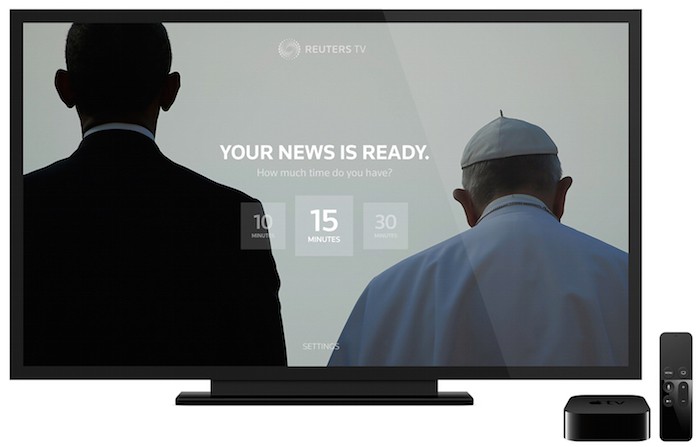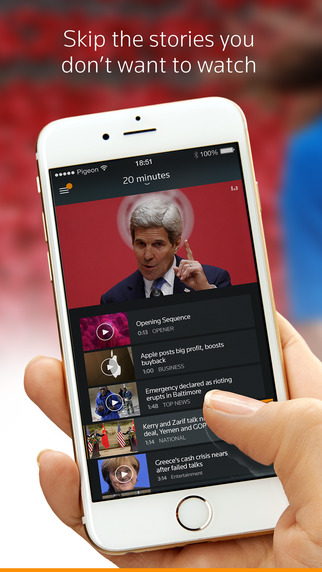
In a little less than a year, Reuters has completely changed the strategy around its news video product, Reuters TV. It’s gone from charging for its iOS app to not just giving its content away for free across many platforms, but also letting other publishers use that content on their own sites and in their own apps.
That strategy is paying off in terms of recognition — Apple calls the Reuters TV app one of its “essentials” — and uptake.
 When Reuters TV was first launched as an iPhone app last February (don’t confuse this with the Reuters TV YouTube channel, by the way, which was launched in 2012 but no longer exists), it had a paywall: $1.99 a month, with limited ads. The app lets users choose how long they have to watch — anywhere from 5 to 30 minutes — and then creates a program of news clips tailored to time and interest. Reuters TV is sleek and well designed; its content changes based on your past viewing activity, and it is a genuinely good way to catch up on the news quickly. (You can even download episodes for offline viewing.)
When Reuters TV was first launched as an iPhone app last February (don’t confuse this with the Reuters TV YouTube channel, by the way, which was launched in 2012 but no longer exists), it had a paywall: $1.99 a month, with limited ads. The app lets users choose how long they have to watch — anywhere from 5 to 30 minutes — and then creates a program of news clips tailored to time and interest. Reuters TV is sleek and well designed; its content changes based on your past viewing activity, and it is a genuinely good way to catch up on the news quickly. (You can even download episodes for offline viewing.)
But a paywall on an unknown video app hindered adoption. “We were best served by loosening that barrier, particularly at an early stage,” Reuters TV managing director Isaac Showman told Digiday last year. Last August, Reuters dropped the paywall on Reuters TV (users can still choose to pay $1.99 a month for an ad-free version). It’s launched the app on iPad, Apple TV, and web — with web app users now accounting for 25 percent of all the app’s active users, even though the web app only launched last month.
In November, Reuters launched Reuters TV for Publishers. “It allows any publisher to come to our website and, free of charge, download a widget that integrates onto their site” and provides a five-minute, curated news program,” Showman told me. “They’re able to put their ads in front of it and they keep 100 percent of the revenue.” The signup process is designed to be quick; publishers customize their fonts and insert ad tags, then get the code for the embeddable widget.
The payoff for Reuters, Showman said, is that more people become familiar with Reuters TV’s brand. The Reuters TV for Publishers app includes links back to Reuters’ website and social sharing buttons, as well as an option for users to enter their phone number to get a download link for the mobile app.
“Sometimes we’re going to reach consumers on our own platforms, and sometimes we’re quite happy for that to be on other people’s platforms,” Showman explained. “If we can contribute to other publishers’ success as a part of that, it’s a win-win for both of us, and something we’re really happy to do.”
Since the offering rolled out in November, “dozens” of publishers have integrated it onto their sites, “with more signing up each day,” Showman said. Reuters wouldn’t give me a full list of participants, but pointed me to an Entrepreneur.com article and to Canada’s Globe and Mail. (If you have an adblocker turned on, you have to turn it off to see Reuters TV’s widget.)
The Globe and Mail added the widget to its main news page on December 9, and plans to roll it out on mobile later this week. “We’re testing reader appetite for five-minute news verticals,” Cynthia Young, The Globe and Mail’s head of audience, told me. “We wanted to see whether our readers like that kind of packaging for news.”

Of the users who view Reuters TV on The Globe and Mail’s site, 20 to 25 percent of them watch the entire five-minute program, according to Young. “We expect to see higher than that on mobile,” she said. (The Globe and Mail audience’s use of adblockers is not particularly high, she noted.) The Globe and Mail — and other Reuters TV for Publishers users — have to go back to Reuters to ask for analytics, though “their turnaround is quick.”
In general, experimenting with products like this is a great way for a publication to “test out content theories,” Young said. “We could produce a similar thing, but Reuters has done the format very well.” Down the line, if The Globe and Mail were to decide to produce its own short news segments — say, with a Canadian emphasis — “we would work with Reuters to look at the product they’re producing and, maybe, figure out some ways that we could license it.”
Reuters has put a lot of work into the technology behind Reuters TV. Each time that Reuters decides to do a news story as a video, it produces three lengths of that story — “small, medium, and large.” The app’s algorithms choose the right video length to deliver to each user based on the amount of time the user wants to watch for and that user’s past preferences. The algorithm also accounts for users’ locations and interests and the judgment of editors. An internal tool lets Reuters analyze each video’s performance to see how it resonates with a small sample group of users before it’s pushed out to a larger group.
The 15-minute program has been the most popular option on Reuters TV’s various apps so far, Showman said, because that’s the default. World news is the most popular coverage category.
So far, Reuters’ new strategy appears to be paying off. Active users tripled between the third and fourth quarters of 2015, though Reuters wouldn’t give me an actual user number.
“The technology that goes into this is state-of-the-art stuff,” Showman said. “We believe other news organizations shouldn’t just leave other platform builders to build, but should be at the forefront of this.”